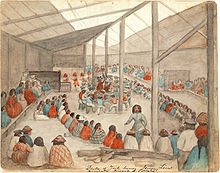
Back اقتصاد الهبات Arabic Икономика на даровете Bulgarian Economia del regal Catalan Парнелев экономики CV Gaveøkonomi Danish Schenkökonomie German Gift economy English Economía del don Spanish Lahjatalous Finnish Économie de don French

A gift economy or gift culture is an economic model, where goods are not sold, but they are given away, without an explicit agreement for immediate or future rewards.[1][2] There are social norms and customs about the exact way the gift is given. In a gift culture, gifts are not given in an explicit exchange of goods or services for money, or some other commodity or service. In contrast, in a barter economy or a market economy goods and services are exhanged for a received value, usually money.

Anthropologists discussed the nature of gift economies. Research began with Bronisław Malinowski's description of the Kula ring[3] in the Trobriand Islands during World War I.[4] The Kula trade appeared to be gift-like because Trobrianders would travel great distances over dangerous seas to give what were considered valuable objects without any guarantee of a return. Malinkowski had a discussion with French anthropologist Marcel Mauss: This showed that gift economy was more complex that they first thought. They also introduced a number of technical terms to describe the different forms of exchange. Some of these terms are reciprocity, inalienable possessions, and presentation.[5][6]
Anthropologists Maurice Bloch and Jonathan Parry think that the unsettled relationship between market and non-market exchange will attract most attention. Some authors argue that gift economies build community, while markets harm community relationships.[7]
Some things that make gift exhange different from other forms of exhange. Usually, the idea of property, and property rights are different. Sometimes gifting forms a distinct "sphere of exchange" that is an "economic system". Giving a gift always establishes a social relationship. The nature of giving a gift in a market economy,is very different from "prestations" typical of non-market societies. Gift economies also differ from related phenomena, such as common property regimes and the exchange of non-commodified labour.
- ↑ Cheal, David J (1988). "1". The Gift Economy. New York: Routledge. pp. 1–19. ISBN 0415006414. Retrieved 2009-06-18.
- ↑ Offer, A. (August 1997). "Between the Gift and the Market: The Economy of Regard" (PDF). The Economic History Review, New Series. 50 (3): 450–476. doi:10.1111/1468-0289.00064.
- ↑ Malinowski, Bronislaw (1922). Argonauts of the Western Pacific. London.
{{cite book}}: CS1 maint: location missing publisher (link) - ↑ Keesing, Roger; Strathern, Andrew (1988). Cultural Anthropology. A Contemporary Perspective. Fort Worth: Harcourt Brace and Company. p. 165.
- ↑ Mauss, Marcel (1970). The Gift: Forms and Functions of Exchange in Archaic Societies. London: Cohen & West.
- ↑ Weiner, Annette (1992). Inalienable Possessions: The Paradox of Keeping-while-Giving. Berkeley: University of California Press.
- ↑ J. Parry, M. Bloch (1989). "Introduction" in Money and the Morality of Exchange. Cambridge: Cambridge University Press. pp. 8–12.
© MMXXIII Rich X Search. We shall prevail. All rights reserved. Rich X Search